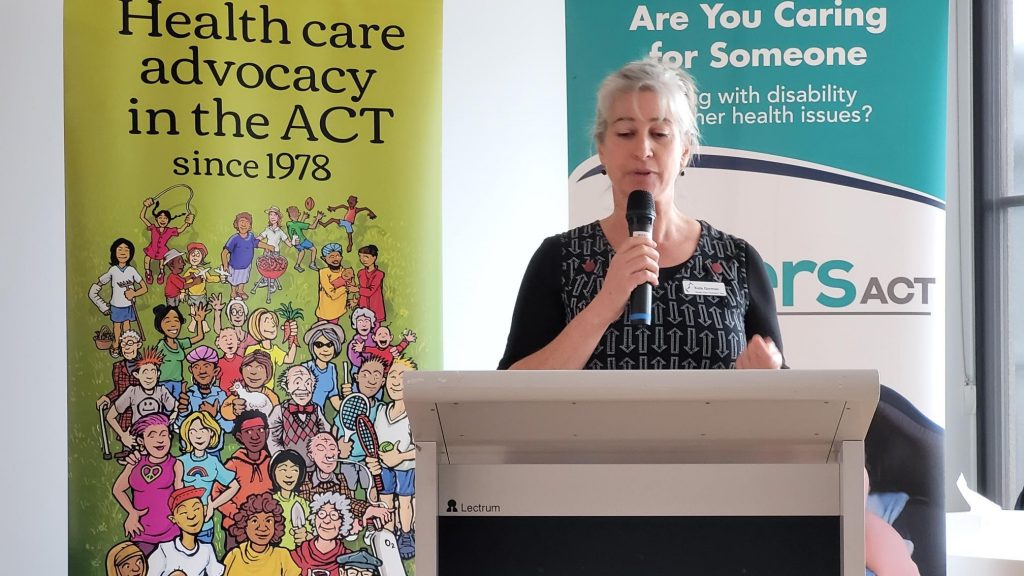Publications
Consumer Participation in Health Infrastructure Projects by Kate Gorman
15 June 2021
Kate Gorman is the Manager of Consumer Participation at the Health Care Consumers’ Association (HCCA) and is also the Chair of the Consumer Reference Group for the Canberra Hospital Expansion Project. Kate spoke at the Thank You event for Consumer Representatives at the ACT Legislative Assembly on 9 June 2021. Her speech is below:

I would like to acknowledge that we meet on Ngunnawal land and pay my respects to elders past, present and to emerging leaders.
HCCA first received funding to provide consumer input into infrastructure projects in 2008. Since this time we have been part of infrastructure projects big and small across the ACT. Consumers have had input on the Canberra Region Cancer Centre, the University of Canberra Hospital, walk-in centres and community health centres, and renovations to buildings and improvements to wayfinding on the Canberra Hospital and Calvary campuses.
Health infrastructure is expensive, and buildings are intended to last for up to 50 years. That means that in some places we must manage as best we can with infrastructure built in a different era, to different standards and with different models of care. We know that health staff working in those spaces share some of consumer’s frustrations with old buildings and are doing the best they can to provide good care. But with every new health building or renovation, we have an opportunity to make access to health care better, and improve the quality and safety of health care, for consumers.
It might not at first glance be evident how consumer input into buildings and their surrounds can affect the quality of health care.
You might say, ‘don’t we have building standards which tell us how health buildings must be built?’ Yes we do but they are minimum standards, and in some cases, especially when talking about the diversity of disability, meeting the standards still results in building design that falls short of consumer needs. Consumer advice can fill that gap between what the standards say, and what is required for good, safe care, for these particular people, in these particular circumstances.
Here’s an example. Consumers often tell us that they would like to stay in single rooms when they go to hospital- that is, to be in a room by themselves. This has not been the norm, historically, for how hospitals are set up. But you know, if you’ve ever been in hospital, or visited someone…We catch distress and anxiety from the people around us. We need privacy in some of the most difficult times of our lives. Our care can be improved by having carers stay with us. We might have needs to do with our culture or faith. There’s a growing recognition that incorporating these elements is a part of providing high quality health care.
But sometimes there is an attitude that these things are a luxury, or perhaps more than is needed for medical care. That is not the case- these elements have a role in patient safety.
To illustrate what I mean, a friend’s mother, with mild dementia, was recently an inpatient in a two-bed hospital room. There was a male patient in the next bed. She could not remember who he was and became very afraid of him. Her anxiety meant that she was distressed about her safety and was continuously trying to get out of bed and leave the room. All through the night. She exhausted herself and her carer who was staying to help and reassure her – in a chair next to the bed. She was already at risk of hurting herself by falling- and this increased her risk of falls even more. She also needed extra medication to manage anxiety.
So here is a person who, a few days into her stay, is in worse shape that she was when she was admitted- and this is before her surgery has happened. These extra risks for her are, in part, the consequences of infrastructure design. If she had her own room, the risks could be much reduced. So when we talk about consumer input into infrastructure design, to improve the quality of care and the outcomes for patients, these are the kinds of things that we mean. High ratios of single rooms in inpatient spaces is something that we continue to advocate for.
We understand that there are places where it’s necessary to have more than one patient in a room, for example where patients need a high level of monitoring. And for these situations, consumers tell us that it’s important to have single gender rooms. That brings us to models of care- because infrastructure is only half of the story when it comes to how care is provided. Models of Care- the rule around how care is provided- are the other half. And in fact, models of care are the part that should come first. We can start by asking, at that moment when we have the opportunity to build something new, ‘what is the optimal way to meet consumers needs and provide medical care to them?’ and the question after that is ‘what would the building or space look like, that would make that model of care possible?’.
Of course we acknowledge that there are constraints – there is budget, there is workforce- there are old buildings- but let’s not start with what we can’t or won’t do, or leave consumer and carer input out of the beginning of this conversation. Let’s start with what health professionals think would provide the best care, let’s combine that with asking consumers what they need in health care, and let’s start there.
Right now you’ll be aware that the major piece of infrastructure on the health horizon is the new Critical Services Building on the Canberra Hospital Campus. Construction will begin on this by the end of the year. Consumers and carers are, and will continue to be involved in shaping this work. And at this point I’d like to acknowledge and thank the many consumer, carer and advocacy organisations who we’ve been working closely with on this project in recent times. Your perspectives, informed by lived experience add a depth to the consumer advice on these projects that is invaluable.
I also want to thank our health service partners, and our government colleagues, for their support for consumer participation in infrastructure.
I hope that you can see the value of what we are doing in this area of advocacy, and I look forward to working together on this over the coming years. When consumer advice influences the design of our infrastructure, it will provide us all with better health care.

